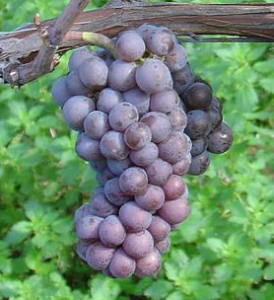 Pinot Grigio (or Pinot Gris, but more on that later) has long been a wine scorned by experts. It is thought to be a wine easy to drink—light on acidity, structure, and aroma; in other words, only good for those whose palates aren’t sophisticated enough to enjoy the truly great things about wine. But is this reputation deserved?
Pinot Grigio (or Pinot Gris, but more on that later) has long been a wine scorned by experts. It is thought to be a wine easy to drink—light on acidity, structure, and aroma; in other words, only good for those whose palates aren’t sophisticated enough to enjoy the truly great things about wine. But is this reputation deserved?
First off, let’s clear up the name issue: Pinot Gris is a long-grown grape varietal nearly genetically identical to its red cousin, Pinot Noir (the color difference between the two is due only to a genetic mutation, and in fact, the leaves and vines of the two plants are so similar that the color is the only way to tell them apart). In Italy, clones of Pinot Gris are called Pinot Grigio. In California, many winemakers copy the Italian style and also change the “gris” to “grigio” because of their wines’ similarities to the Italian style.
“Pinot” means “pinecone” in French, and might reflect the fact that Pinot Gris/Grigio grapes grow in pinecone-shaped and –sized clusters. “Gris” means “grey,” and is so called because the grapes are usually bluish-grey (but can often be brownish, pinkish, or even almost white or almost black). The wine produced from the grapes can be a variety of yellows, from copper to gold to pinkish to almost clear.
Pinot Gris most likely spread from Burgandy along with Pinot Noir about 700 years ago. Since 2005, it’s been one of the most popular wines with consumers (if not with critics), and today is sold in competing numbers with Sauvignon Blanc, a wine so popular that it is grown in almost every location in the world that will support it. But despite its growing popularity among casual drinkers, Pinot Grigio has kept its poor reputation with serious drinkers.
Most Pinot Grigio deserve its stigma. It is often an unimpressive wine, without much flavor or aroma to speak of. But with its increased popularity has come some increase in quality. A good Pinot Grigio will be a highly acidic wine, perfect for light summer foods, especially those prepared on the grill. It can be highly mineral-tasting, a clean, crisp backdrop to the terroir, an honest reflection of the soil in which it was grown. A good Pinot can have a pleasant aroma of pears, apples, or flowers.
If you’re willing to give Pinot a second chance, start with the Italian and Californian Pinot Grigios, as their flavors are usually superior. Another great region for Pinot Gris is Alsace, France, which grows the grape on nearly 14% of its available vineyard space. The cool climate, warm, volcanic-rock soils, and long, dry fall seasons, which allow the grapes plenty of time to mature on the vine and develop the deep flavors that many Pinots lack, is the perfect environment for the Pinot grape.
Pinot Gris or Grigio is a perfect example of a wine in which reputation should not play too strong a role in your opinion. Go out and try Pinot for yourself—you might be surprised with what you find.


